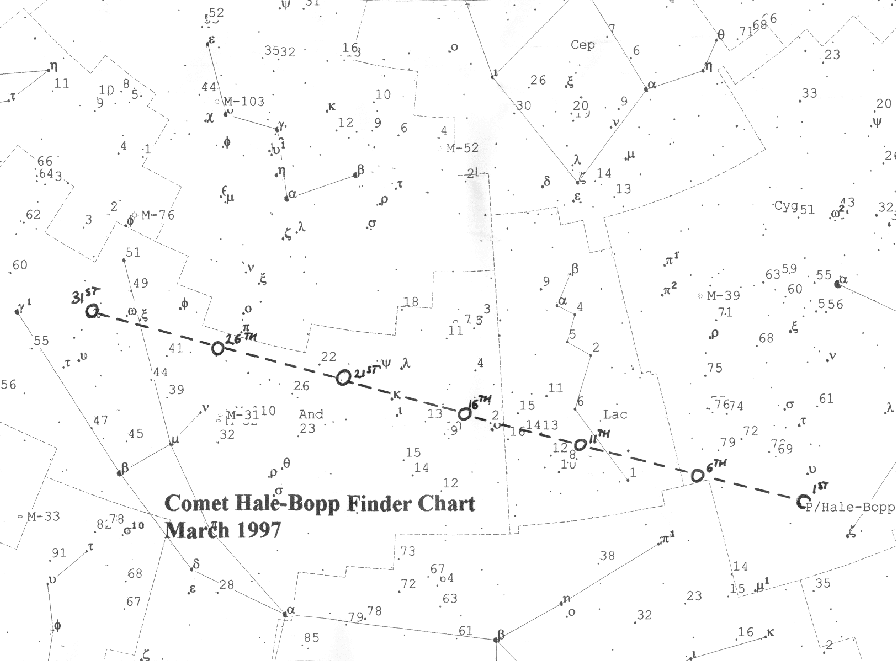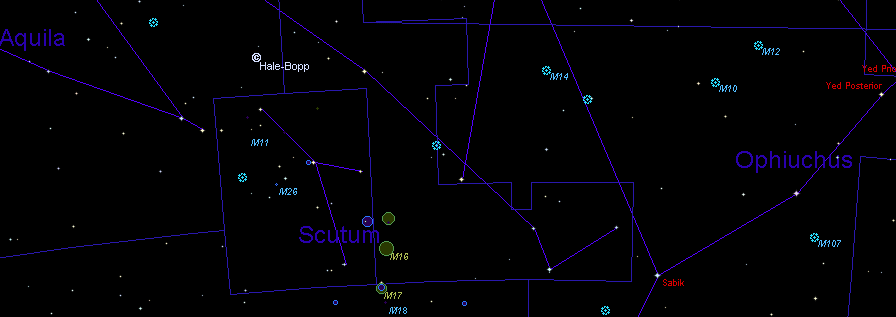 Figure 1. Path of Hale-Bopp through the heavens in March 1997.
Figure 1. Path of Hale-Bopp through the heavens in March 1997.
Orwell Astronomical Society (Ipswich)
Comet C/1995 O1 (Hale-Bopp), 15 October 1996 - 31 March 1997
On 22 July 1995, Alan Hale and Thomas Bopp, two observers from Arizona, discovered the comet which now bears their name. At the time of its discovery, the comet appeared as a small object close to M70 in Sagittarius. It probably originated in the Oort cloud, a vast spherical halo of low density, ice-rock bodies orbiting the Sun from outside the orbit of Pluto out to a distance of about 1.5 light years. The Solar System itself is in orbit around the centre of the Milky Way galaxy with a period of some 225 million years and, if its orbit brings it within proximity of another star, it is possible for gravitational interactions to perturb the orbit of a body in the Oort cloud and send it hurtling inwards towards the Sun in a highly elongated orbit. When such a body gets close to the Sun, it heats up releasing gas and dust to form the familiar cometary tail.
By late 1996, Comet Hale-Bopp had become visible to small telescopes and many amateurs were keenly observing it. By mid-January 1997, it had emerged from conjunction with the Sun and crossed the orbit of Mars and, although still over 350 million km from Earth, had become a naked-eye object: this further stimulated interest from amateur observers. In the second week of February 1997, it entered Vulpecula and became a most prominent object in the morning sky. As its motion through the heavens carried it further east (see figure 1), during March 1997 it became very impressive in the early-evening sky.
 Figure 1. Path of Hale-Bopp through the heavens in March 1997.
Figure 1. Path of Hale-Bopp through the heavens in March 1997.
Several members of OASI were able to obtain stunning photographs of Hale-Bopp, some of which are reproduced below. The five images by Mike Harlow were taken with a 125 mm f/5 Newtonian reflector and Starlight Express CCD camera. The three images by Neil Morley were taken with a 35 mm film camera using 58 mm lens at f/2 while the comet was close to its most prominent. Other notes are as follows:
Charles Messier (1730-1817) was primarily an observer of comets. Between 1760 and 1798 he discovered 13 comets and Louis XV of France nicknamed him the ferret of comets. In August 1758, when he was searching near the star ζ Tauri for a comet that he had found some weeks earlier, he found a faint object looking very much like a comet. However, the object did not move against the background stars and it soon became apparent that it was not a comet after all. He decided to make a list of all such objects to prevent further confusion during his searches. The object near ζ Tauri thus became the first entry on his list, designated M1: it was, of course the Crab Nebula. (Discovered by Bevis in 1731, unknown to Messier.) In 1760, Messier listed his second object, describing it as resembling the nucleus of a comet. It was a globular cluster in Aquarius, designated M2.
In 1764, Messier began a more systematic search for objects that could be mistaken for comets, and went on to publish several versions of his list as it grew in subsequent years. The first version, published in 1771, contained 45 objects. By 1783, it had grown to 70 objects. In 1784, Messier published the third version of the list containing 103 objects.
Around the time that Hale-Bopp became visible in amateur telescopes (late 1996) it was situated close to several Messier objects and there therefore arose an opportunity to use Messier's catalogue for its original purpose - to distinguish a potential comet from apparently similar objects! Figure 16 shows the location of Hale-Bopp when it was photographed by Mike Harlow (figure 1 above, 15 October 1996). At this time, the comet was just north of Scutum and within a few degrees of six Messier objects, as listed in table 1. In practice, of course, this chance positioning was of purely academic interest, and it was not necessary to rely on Messier's catalogue to identify Hale-Bopp: modern communications meant that the precise co-ordinates of Hale-Bopp and its position in relation to nearby reference stars were widely available within the astronomical community.
 Figure 16. Hale-Bopp and nearby Messier objects in mid-October 1996.
Figure 16. Hale-Bopp and nearby Messier objects in mid-October 1996.
Object
Constellation
Coordinates (J2000.0)
Description
Distance from Hale-Bopp (°)
Table 1. Hale-Bopp and nearby Messier objects in mid-October 1996.
OASI hosted a very successful public Open Weekend 11-14 April 1997 to observe comet Hale-Bopp.
James Appleton, Martin Cook, Mike Harlow, Neil Morley, Dave Payne, Alan Smith